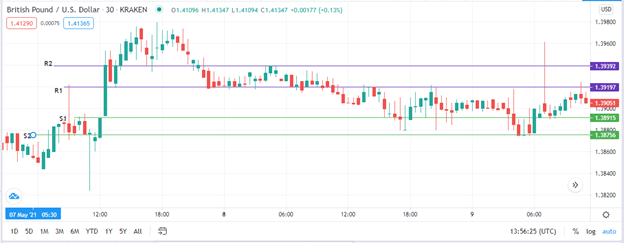Camarilla pivot points use Fibonacci numbers as a basis for establishing important support and resistance levels. The levels are crafted from spreads between the highs and lows of previous trading sessions.
Camarilla equations use the previous session’s lows and highs to come up with four levels below and four above the pivot point. Low point 3 (L3), Low point 4 (L4), High point 3 (H3), and High point 4 (H4) are the most important points. L3 and H3 are trend reversal points, while H4 and L4 are stop loss points. Movements beyond these two levels signal that it’s time to trade the prevailing trend.
Sample Chart:

In the chart above, support levels S2 and S1, as well as levels R1 and R2, are shown. The essence of establishing pivot points is to know two critical decision-making points of trade, namely, stop loss and buy points.
The key points are discussed below:
CP = Closing price for the previous trading session
HP = Highest price recorded in the previous trading session
LP= Lowest price recorded in the previous trading session
R4 = (HP– LP) x 1.1 / 2 + CP
R3 = (HP– LP) x 1.1 / 4 + CP
R2 = (HP– LP) x 1.1 / 6 + CP
R1 = (HP– LP) x 1.1 / 12 + CP
S1 = CP – (HP– LP) x 1.1 / 12
S2 = CP – (HP– LP) x 1.1 / 6
S3 =CP– (HP– LP) x 1.1 / 4
S4 =CP – (HP– LP) x 1.1 / 2
Effective Trading using Camarilla Pivot Points
1st Scenario: Opening price is between S3 and S2
Place your Buy order after the price goes up above S3 from below that point. Mark the S4 as your stop loss price. Go short after the price shifts from above R3 to below it. S1, S2, and S3 will be the profit target levels.
2nd Scenario: Opening price between R3 and R4
Go long when the price goes above R3. Working with margins of 0.5%, 1.0%, and 1.5%, place your stop loss at R3. Go short once the price shifts from above S3 to below it.
3rd Scenario: Opening price between S3 and S4
When the price goes from above S3 then shifts to below it, wait for it to oscillate to R1, R2, and R3, then back to above S3, then Buy. Place the session’s stop loss marginally below S4. Go short once the price swings from S4 to above it, then back below it.
4th Scenario: Opening price above R4
Stakes are high under these circumstances, so only place your buy order once the price goes below R3. Wait for the price to go below resistance R3, and then go short.
Camarilla trading strategies
1) Using Camarilla pivots in range
A range refers to a situation whereby the market price swings between defined resistance levels and support levels. Typically, traders employ Camarilla pivots when they want to establish safe ranges within which to make profits and minimize risk. Pivot points S3 and S4 are important points because range reversals take place between them. Traders find them useful in identifying the best entry points.
By tracking price movements towards and away from the session’s support and resistance levels, traders are better equipped to identify breakout and reversal points. For instance, they will look for a new support level and shift their attention to R3 on the upward.
The establishment of support above S3 is used by traders to buy, with the buy order placed above that point. When this happens, the R3 level serves as the upper range. The range strategy is most reliable during periods of normal price movements but can be misleading in volatile markets.
2) Camarilla pivots in trend trading
Camarilla pivots are useful for trading when the market trend has been well-established as being either upward bound or headed downwards. During such periods, it is easier for traders to determine the optimal levels of profits, when to enter or exit trades as well as stop loss points. For uptrends, S3 will be the point of buying, while the stop loss will be at S4. For downtrends, the opportunity to sell is at R3, while stop loss is placed at R4.
Camarilla pivots achieve better results when used in combination with other relevant indicators. You may employ Fibonacci retracement, EMAs, RSI, etc. You should also be on the lookout for changes in market fundamentals.
Advantages of Camarilla Pivots
- They have been proven to be effective in identifying key entry and exit points for day trading.
- They help reduce risk and can optimize profits if applied appropriately with other indicators.
- The pivots are effective for trading in financial markets.
Weaknesses of Camarilla Pivots
- Not appropriate for long-term trading.
- Not easy to utilize when one is inexperienced.
- Their application is only appropriate in established trends and may lead to losses if applied in volatile markets.
Bottom line
Camarilla Pivot Points are very useful for short-term trading. They give traders important price areas of the most appropriate points to initiate a trade, stop losses, and exit. However, these points should be used in combination with other indicators whenever appropriate to increase their accuracy. Also, they should be applied during specific market conditions and require some learning and mastering to achieve optimal results.
